In-Depth with the Windows 8 Consumer Preview
by Andrew Cunningham, Ryan Smith, Kristian Vättö & Jarred Walton on March 9, 2012 10:30 AM EST- Posted in
- Microsoft
- Operating Systems
- Windows
- Windows 8
As soon as the setup process is finished, you’re presented with your first look at Windows 8’s primary innovation: Metro. This new UI, which originated in Windows Phone 7 and has since been extended to the Xbox 360, is the Wave of the Future at Microsoft, and it’s part and parcel of Windows 8. There is no classic Start menu to fall back on. There’s nothing built-in to the OS that allows you to disable it or boot to the desktop by default (though surely various hacks will enable this if they haven’t already). Metro is here, and if you use Windows 8 you’ll have to come to terms with it.
That’s because Microsoft is going a step further than Apple with regards to its operating systems: while Apple is busy porting iOS features and characteristics to a desktop operating system that is still recognizably OS X, Microsoft insists that the tablet is just another kind of PC, and to that end is building a unified OS for both tablets and traditional PCs. Microsoft tablets (whether running Windows 8 or Windows on ARM) will run the same core software as PCs, will be able to run many of the same apps as PCs, and (most importantly for Microsoft’s ecosystem of enterprise users) can be managed using the same tools as PCs. We’ve known for years that the traditional Windows desktop doesn’t work well on tablets, but does an interface designed for touch also work with a mouse and keyboard?
 Metro, with its large fonts, bold colors, and large buttons was designed to be touched, and I think once we get some tablets designed for Windows 8 people are going to warm up to it. It’s well thought-out and with a little polishing will stand up well to iOS and Android in terms of features, and in terms of aesthetics it's already there—animations are fluid and attractive, and nice touches like a volume overlay (see right—finally!) bring an extra level of modern polish to Windows.
Metro, with its large fonts, bold colors, and large buttons was designed to be touched, and I think once we get some tablets designed for Windows 8 people are going to warm up to it. It’s well thought-out and with a little polishing will stand up well to iOS and Android in terms of features, and in terms of aesthetics it's already there—animations are fluid and attractive, and nice touches like a volume overlay (see right—finally!) bring an extra level of modern polish to Windows.
Brian Klug and Ryan Smith talked a bit about using Metro on a tablet in their piece on September’s Windows 8 Developer Preview, a process which is more or less the same in the Consumer Preview, so what I’ll be focusing on here is the general layout and function of Metro in the Consumer Preview, and my experience using it with a keyboard and mouse.
Introducing Metro
We’ll start with the entry point: the new login/lock screen. In previous Windows versions, this screen told you nothing about the computer—it was simply a gateway, and as such it either showed you a list of user accounts on the computer or displayed a CTRL + ALT + DELETE prompt with username and password fields. In Windows 8, the lock screen shows you the date and time and your current battery life and network connectivity status, set against a user-configurable background. Other Metro apps, like Mail and Messages, can also be configured to display status and notification messages on the lock screen. The look is reminiscent of most tablets and smartphones, but its big, high-resolution, striking images reminded me more of the Kindle Fire than anything. It’s a nice effect.
Press any key on your keyboard and the login image will slide upward, revealing the traditional Windows name and password fields. Authenticate, and you’ll be looking at the Metro-style Start screen.
Tiles for Metro-style apps are big and colorful, and can usually be set to two sizes, a smaller square that allows for two tiles to sit side by side in a column, and a longer rectangle that spans the entire column. Metro columns on the Start screen will expand or contract to fill all of the screen resolution available to them, as evidenced in the screenshots above and below, and your mouse or trackpad’s vertical scrolling function will let you move left and right (horizontally, I know) through all of your apps. You can also scroll by grabbing the scrollbar at the bottom of the screen, or by moving your mouse pointer all the way to the left or the right of the screen.
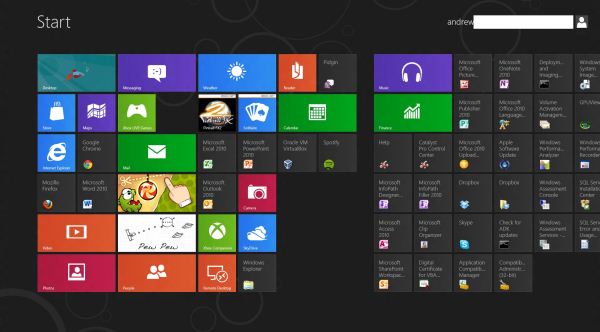
Displays with more pixels can display more items
Above, you can see most of what constitutes a Metro page: tiles of apps lined up into neat columns. Tiles can be moved around at will, and will try their best to rearrange themselves dynamically. The wider gap between two of the columns is a divider between “pages” of apps. There is no limit to the horizontal size of pages, and you can freely drag tiles to either side of these wider divides.
Right-clicking a Metro app will bring up a list of actions at the bottom of the screen—most Metro tiles will let you shorten or lengthen them, remove them from the Start screen, or uninstall them.
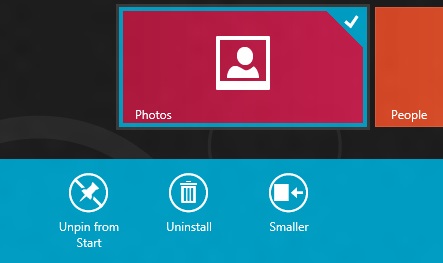
Standard desktop programs also show up on the Start screen as rather unglamorous-looking gray tiles that show the name of the program and its icon. Left clicking on it will dump you to the desktop and open the app as it would open in older versions of Windows, and right-clicking will bring up that app’s standard right-click menu in the Metro style across the bottom of the screen, with the added option to uninstall the program without going into the Programs and Features control panel.
To add and remove desktop app icons from the Start screen, right-click them and then click “pin to Start.” Desktop apps can be pinned to and unpinned from the desktop taskbar and the Start screen from the desktop or from Metro, the first of many ways in which the two interfaces are integrated.
Windows Search can be invoked automatically from the Start screen if you begin typing. In Windows 8, there are three distinct search categories: Apps, which will display most Metro and desktop programs; Settings, which will search through the Metro and desktop control panels; and Files, which is self-explanatory. You can also search through any Windows Search-enabled Metro app, which you can see listed below the three main headings. I’d love to see a unified search group like we had in the Windows 7 Start menu, especially given the sometimes-blurry line between what appears in Settings and what appears in Apps, but search in Windows 8 is powerful and it’s fast, even using slower processors and mechanical HDDs.
All Metro apps, including the desktop, can be “snapped” to the left or right edge of the screen, which lets one app use up about a fifth of the screen while another app uses the remaining space—I’ve seen this called “Metro Snap” and that’s how I’ll refer to it for the rest of the article. This is especially useful for things like Twitter or messaging clients that work well with a single vertical strip of screen space. Metro Snap will only work on panels that are 1366x768 or higher—anything smaller has too few horizontal pixels to make effective use of the feature—but the Windows desktop’s Aero Snap features will continue to work as they did in Windows 7.
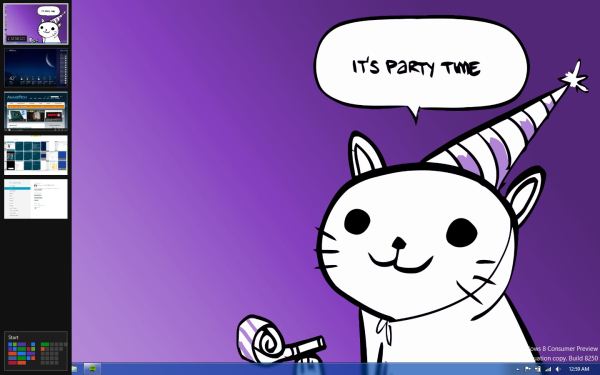
Party Cat knows when it is time to party. Also, the app drawer is on the left.
Metro has a few menus that can always be brought up no matter what app you’re using: the left edge of the screen is for an application drawer (above), which serves a function similar to the application switchers in iOS and Android. It shows all of your currently running apps and allows you to either switch to them from the currently running app or close them. The desktop will show up in the application drawer as a single item regardless of how many programs you have running on it, and while you can “close” it, this only makes the tile vanish from the drawer, and won’t close any of the programs running on the desktop.
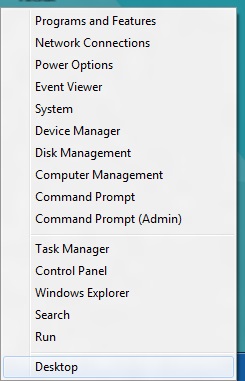
Update: Several readers have pointed out that right-clicking in the lower left corner of the screen brings up a mini-Start menu of sorts, where the Explorer, Search, the Run dialog box and several control panels can be accessed more easily. Thanks to all who sent this in!
The right edge of the screen is for Charms (above), Microsoft’s name for the buttons that let you access several high-level settings and features. The Charms are, from top to bottom:
- Search, which brings up the Search menu (which, remember, can also be invoked by typing from the Start screen). The default search view is Apps.
- Share. While in a Metro app like Photos, you could use this charm to send a picture to someone using another Metro app like Mail.
- Start, which brings up the Start screen.
- Devices, which brings up attached devices like printers and extra monitors and gives you some configuration options for them—for instance, it will allow you to change your display settings if you’ve got a second monitor or projector attached, and it will bring up a Print menu if you click an attached printer. This charm is context-sensitive—if there’s nothing in your app to print (or if the app doesn’t support it), for example, any printers attached to your computer won’t show up in the menu as a selectable option.
- Settings. This brings up both general settings and options for the currently-running application as well as some system-wide settings like brightness, volume, notifications, language, network connectivity, and shutdown options. The “More PC Settings” link brings up the system-wide Metro control panel, where one can control things like the lock screen and Metro backgrounds, your PC’s refresh and reset functionality, and a few other settings.
Screen resolution requirements
As we’ve discussed, using Metro Snap requires a screen resolution of at least 1366x768, but there’s one more very important resolution requirement in Windows 8.
While working on my netbook, I quickly found that almost all Metro apps included in the Consumer Preview wouldn’t run on its 1024x600 display. After some research I found that, yes, Metro apps are only going to run on screens that are 1024x768 or higher. It’s important to give developers a minimum screen resolution to shoot for (and we may even see some tablets that use 1024x768 panels, given the precedent set by the iPad, the HP TouchPad, and others), but it means that users of PCs with smaller screens aren’t going to be able to use Windows 8’s defining feature (though the Start screen and system menus will still work just fine). This is too bad, since the limited amount of screen space on a netbook is a decent fit for Metro's simplified interface and full-screen apps.
Now that you know the basic features and layout of Metro, it’s time to teach you how to use it with a mouse and keyboard.


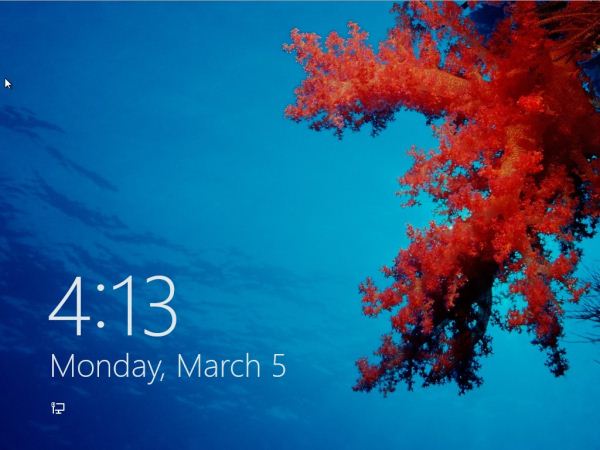
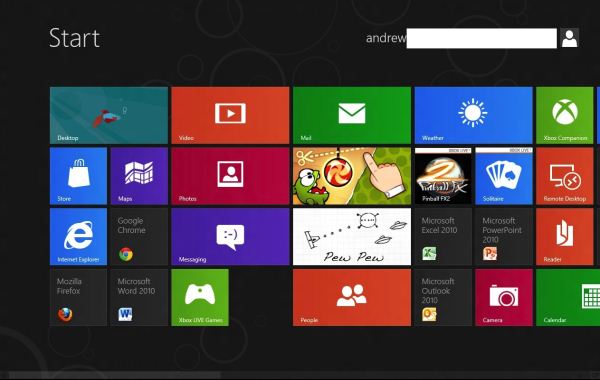
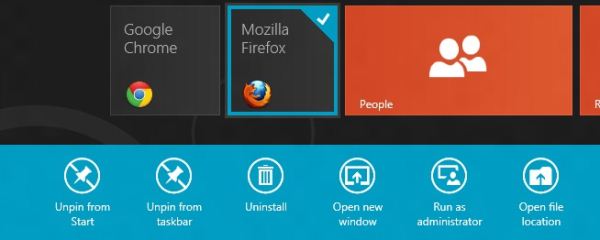
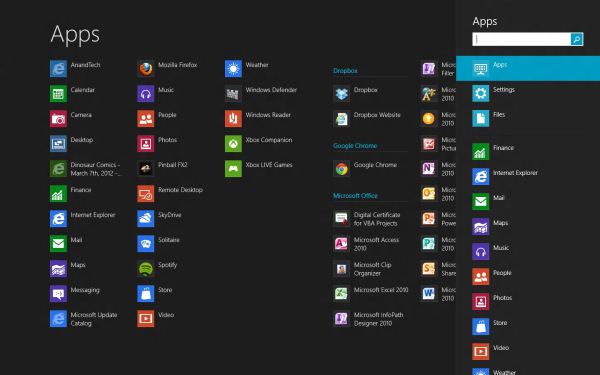
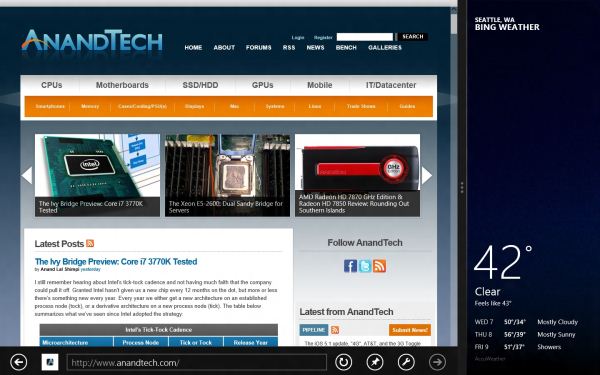
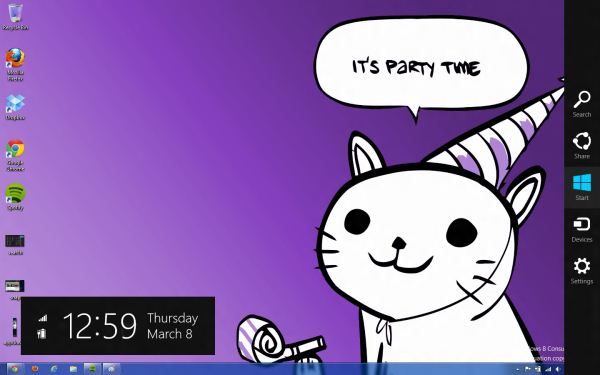








286 Comments
View All Comments
Braden99 - Friday, March 9, 2012 - link
I work with applications like Maya, Photoshop etc. and find my productivity has not been effected at all in Windows 8. Most of the complaints about Windows 8 are grossly exaggerated, by users who cannot easily adapt to change. MS needed to do something big to insure relevance into the future, prepare for new hybrid devices, and entice a new generation of users, and for the most part every feature of the old start screen is still present. The desktop still exists, and explorer has more features than ever. Those "power" users would have probably been using the keyboard to activate and search through start menu, and now they still can, with same number of key presses (yes a context switch, but only for a second, or as quick as you can type and press enter).That said I'm hoping for a lot of tweaks that improve the features and direction MS are already going in - That's what I'm focusing on my attention on.
ananduser - Friday, March 9, 2012 - link
Fair review, impressed by Win8, don't care about GUI sensibilities, I never criticized any OS for subjective GUI peculiarities.Battery issues might also stem from lack of custom drivers that are the norm in laptop land. Anyway I might be wrong seeing as they should work in W8. Maybe they do but don't use W8's touted power saving features.
Why always bring the subject of OSX price vs Win's price ? OSX is an upgrade, it has a requirement that you detain the previous version. Win is sold as a stand alone product(upgrade options exist as well). Now, ever thought about "you get what you pay for"(mac fans always love this phrase) ? W8 will bring out of the box built in hypervisor, storage spaces and incredibly huge hardware support(among many others). Also you can virtualize W8 in any VM. OSX lacks all that and has less hardware support, in fact has hardware restrictions. Bottom line Windows costs more because IT IS WORTH MORE.
PS: Did you really need 2 imacs and a mba to test W8; one Apple PC wasn't enough ?
Braden99 - Friday, March 9, 2012 - link
"but there’s still no way to use a different wallpaper for each desktop, something that OS X has supported forever"Actually you can in Windows 8. Go into Personalize>Click Desktop Background>Then you can right click pictures, and say set as monitor 1, or 2
Braden99 - Friday, March 9, 2012 - link
"but there’s still no way to use a different wallpaper for each desktop, something that OS X has supported forever"Actually you can in Windows 8. Go into Personalize>Click Desktop Background>Then you can right click pictures, and say set as monitor 1, or 2
superPC - Friday, March 9, 2012 - link
I see that most of you complains about the new start screen. well my father asked me to installed windows 8 on his laptop and he's much happier than he ever was with that laptop (it use to be a vista machine). it loads up in less than 40 seconds (not using SSD old core 2 duo machine with just 1 GB of RAM), shuts down in less than 30. it's super responsive and just plain fast (eventhough i've already installed all of his regular software suite). and he loves the new metro browser and apps. full screen apps looked lovely he said. he even likes metro because "it's more informative and searchable than the old start menus". honestly, windows is not aim at people like us the power user, it's aim at the rest of them: casual users. and if my dad, a 25 year veteran casual user of windows can live with metro than most of us obviously can too.p05esto - Friday, March 9, 2012 - link
That's great that it's dumbed down, but my question is WHY are you here on anaddtech? This is a site for real computer users who don't want it dumbed down.MS needs to allow advanced users to turn all the Metro crap off and use the OS just for launching their development apps. We don't want ANY of the crap found on the start screen or the hidden corners or whatever. I don't understand why MS is removing all customizability, it's been getting worse ever since Vista. Even in Office, why force the stupid ribbon, why not let power users use regular menus? I don't get why they force everybody to follow the same strict path. How hard can it be to allow people to bypass the metro start screen and put back the start menu with all their apps?
Oh, and bring back the option to organize apps in the start menu into folders so I don't have to look through 50 apps to see all my graphic editing programs or video programs (I liked putting them into broad folders of apps). Win7 eliminated that possibility. And bring back the SMALL and condensed task menu of apps. In Win7/8 they use these large icons with too much space on the sides...why? I found a registry hack to make them smaller and compact, but why make the large and cumbersome task bar area thre default? It befuddles me.
smilingcrow - Friday, March 9, 2012 - link
p05esto: “My question is WHY are you here on anaddtech? This is a site for real computer users who don't want it dumbed down.Oh, and bring back the option to organize apps in the start menu into folders so I don't have to look through 50 apps to see all my graphic editing programs or video programs (I liked putting them into broad folders of apps). Win7 eliminated that possibility.”
Win7 does allow you to organize your apps into folders on the start menu (after you click on All Programs) but it is not as simple as with previous versions. As you are a ‘real computer user’ I will allow you to find that info for yourself; which will be easy now that you know that it is possible which is the hardest info to get.
bigboxes - Friday, March 9, 2012 - link
Right-click task bar -> Properties -> Task bar tab -> check "Use small icons"freedom4556 - Friday, March 9, 2012 - link
Most of the improvements your dad talked about could be attributable to simply clean re-installing an old Vista install and then running updates. The switch to seven would likely have had a similar effect on performance.Sabresiberian - Friday, March 9, 2012 - link
An operating system, particularly one as ubiquitous as Windows, should appeal to ALL users, not just the lowest common denominator.There is a difference between making things easier to use for the non-technical person and dumbing down, and sometimes Microsoft loses sight of that.
Reading this article, I don't think Win 8 is necessarily "dumbed down" in it's interface, but I'm not entirely convinced. I do know, I'm not going to live with an OS that requires me to interface with it through big squares on a solid-color background.
I have a lot of trouble understanding why I would want to buy an "app" to begin with, since many of them seem to be nothing more than bookmarks. I seem to have been able to do without them for all the time I've used computers to now, I don't see why using a smart phone or tablet requires them, or even makes those devices better. I don't understand why we can't just have icons like the previous versions of Windows that we can touch to activate, if we want to activate them by touch and have the hardware capability.
This article has allayed some of my fears, and there is clearly enough reason to update from Vista to Win 8 on my next build, providing I can get rid of the yugly (yugly: you'-glee, as in "so ugly it's beyond ugly, it's yugly") interface. My second computer uses Win 7, and I'll have to be very impressed with Win 8 to switch from it when I rebuild a second computer.
Most people in the world that interface with computers are not technically inclined; many of them aren't all that capable in any case. It's good for these things to be easy enough to use that most everyone can use them, just please, please don't penalize ME in the process.
It will take a lot for me to give up DirectX, but I would do it, if it becomes necessary.
;)